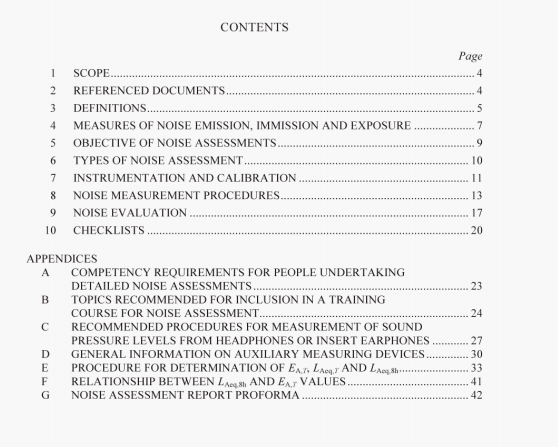AS/NZS 1269.1:2005 pdf – Occupational noise managementPart 1: Measurement and assessment of noise immission and exposure.
6.2 Assessment for noise reduction
Where the results of an assessment indicate the likelihood of exposure to excessive noise. then further investigations are needed to identify the sources of noise and to determine priorities for noise reduction. These investigations shall be carried out by a conipetent person preferably with appropriate expertise in engineering noise control and may require the use of special instrumentation. Upon identification of the major sources of excessive noise, reference shall be niade to ASINZS 1 269.2.
6.3 Assessment for personal hearing protector program
Where an assessment of noise exposure (see Clause 6.1) indicates exposure to excessive noise and where legislation or the organi/ation s noise policy requires the issue of hearing protectors. measurements shall be carried out by a competent person in those areas where people are exposed to excessive noise, with a view to establishing sound attenuation requirements for hearing protectors.
This shall involve measurement as described in Clause 8.5 and calculation of sound attenuation requirements in accordance with AS/NZS 1269.3.
In general. if the noise can be described as broadband noise, then the classification method is suitable. However, if the noise is narrowband in character with significant tonality or has significant high or low frequency components or where LACqh exceeds 110 dB(A). then the octave-band method shall be used. If the noise has significant impulsive components, then the peak sound pressure level shall be measured in order to select appropriate hearing protectors (see AS/NZS 1269.3).
6.4 Assessment of noise exposure from headphones or insert earphones
It may be necessary to measure the noise exposure of a person wearing headphones or insert earphones.
Hand held sound level meter measurements made by competent people are preferred tomeasurements using PSEMs.PSEMs are inherently affected by confounding effects. Theseinclude—shouting across microphones,tapping the microphones,taking the meter off forshort periods,not directing the microphone at the noise source. PSEMs also rely onemployees who are untrained and unskilled carrying out their own noise measurements,often in uncontrolled and unreported areas.
Despite these potential confounding effects,the information provided by modern PSEMscan be a useful component in identifying noise exposure of the person.
Where PSEMs are used, for example in small spaces or in single cab vehicles, the operatorshould be carefully monitored by a competent person to ensure confounding effects are notintroduced or at least minimized.
7.4 Non-integrating sound level meter
Non-integrating sound level meters shall comply with the requirements of AS IEC 61672series (or available superseded AS 1259 series) for Australia, or IEC 61672 series for NewZealand.They provide a reading of the A-weighted sound pressure level.Such instrumentsshall only be used for a preliminary assessment and where the range of fluctuation of soundlevels does not exceed 6 dB(A) when measured in the ‘S’ time-weighting mode at the measurement location.
AS/NZS 1269.1:2005 pdf – Occupational noise managementPart 1: Measurement and assessment of noise immission and exposure
